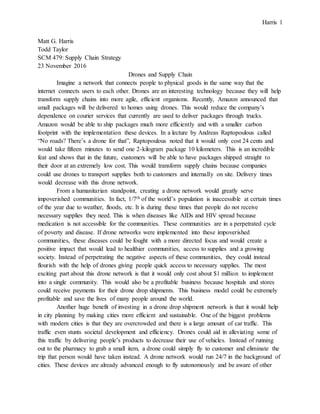
Thought Leadership Paper - Drones and Supply Chain
- 1. Harris 1 Matt G. Harris Todd Taylor SCM 479: Supply Chain Strategy 23 November 2016 Drones and Supply Chain Imagine a network that connects people to physical goods in the same way that the internet connects users to each other. Drones are an interesting technology because they will help transform supply chains into more agile, efficient organisms. Recently, Amazon announced that small packages will be delivered to homes using drones. This would reduce the company’s dependence on courier services that currently are used to deliver packages through trucks. Amazon would be able to ship packages much more efficiently and with a smaller carbon footprint with the implementation these devices. In a lecture by Andreas Raptopoulous called “No roads? There’s a drone for that”, Raptopoulous noted that it would only cost 24 cents and would take fifteen minutes to send one 2-kilogram package 10 kilometers. This is an incredible feat and shows that in the future, customers will be able to have packages shipped straight to their door at an extremely low cost. This would transform supply chains because companies could use drones to transport supplies both to customers and internally on site. Delivery times would decrease with this drone network. From a humanitarian standpoint, creating a drone network would greatly serve impoverished communities. In fact, 1/7th of the world’s population is inaccessible at certain times of the year due to weather, floods, etc. It is during these times that people do not receive necessary supplies they need. This is when diseases like AIDs and HIV spread because medication is not accessible for the communities. These communities are in a perpetrated cycle of poverty and disease. If drone networks were implemented into these impoverished communities, these diseases could be fought with a more directed focus and would create a positive impact that would lead to healthier communities, access to supplies and a growing society. Instead of perpetrating the negative aspects of these communities, they could instead flourish with the help of drones giving people quick access to necessary supplies. The most exciting part about this drone network is that it would only cost about $1 million to implement into a single community. This would also be a profitable business because hospitals and stores could receive payments for their drone drop shipments. This business model could be extremely profitable and save the lives of many people around the world. Another huge benefit of investing in a drone drop shipment network is that it would help in city planning by making cities more efficient and sustainable. One of the biggest problems with modern cities is that they are overcrowded and there is a large amount of car traffic. This traffic even stunts societal development and efficiency. Drones could aid in alleviating some of this traffic by delivering people’s products to decrease their use of vehicles. Instead of running out to the pharmacy to grab a small item, a drone could simply fly to customer and eliminate the trip that person would have taken instead. A drone network would run 24/7 in the background of cities. These devices are already advanced enough to fly autonomously and be aware of other
- 2. Harris 2 drone’s presence to avoid crashes. The device would simply use predetermined routes similar to highways in the air and rejoin the in-air routes once they make their stop. In the future, the technology will continue to develop and allow drones to safely carry heavier packages as well. This could be a new system that fixes a very old problem of urban traffic. So why haven’t drone networks been utilized in cities yet? Even though we have the basic technology to create this drone network, it still needs more tests and tweaks to implement. The technology would have to run perfectly for full implementation. Crashes in the air would be dangerous and could cause injuries or damage to civilian’s property. The tests would have to prove that these crashes would never happen. Another reason that drones have not become a common package courier service is because some people possess negative images of this technology. Since larger drones are used in war, many people associate them with killing machines and are hesitant to allow them into their communities. Also, people are nervous that they can be used as spying machines. Although these are fair concerns, there are always drawbacks with any new technology. Laws and limitations must be implemented in order to make new processes safe for society. I believe that a network of drones utilized in cities will be a large disruptive innovation in supply chain. Not only will they allow businesses to react quicker to customers, it will also allow them to cut down on their carbon footprint. Drones are powered by electricity and greatly reduce the amount of carbon emissions utilized to send small package. Also, drones will change the way cities are designed because traffic congestion will be less of an issue than seen in the past. Another exciting part about investing in drone technology is that there will be plenty of uses for the machine that have not yet even been discovered. Another area they are being used in is the agriculture industry. Farmers are using drones to inspect their crops with high tech cameras to detect for diseases and bad crop. The drones will fly through rows of crops taking data quickly and efficiently. Another use for drones is as a lifeguard to delivery safety rings to victims before the human lifeguard arrives. As one can see, there are many other useful applications for drones that are unrelated to supply chain. Regardless, this drone network will aid in developing societies and make our cities a more livable place. Personally, I am excited to see where this technology takes our society in the next 5-10 years.